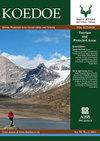Morphometric regressions for the endangered Knysna seahorse, Hippocampus capensis, in the Swartvlei Estuary from mass stranding events
IF 1.1
4区 环境科学与生态学
Q3 BIODIVERSITY CONSERVATION
引用次数: 0
Abstract
The Knysna seahorse, Hippocampus capensis, is listed as endangered on the IUCN Red List of Threatened Species, with the only known, apparently isolated, populations occurring in the Knysna, Swartvlei and Keurbooms estuaries along the south coast of South Africa. The Swartvlei Estuary population is the most genetically distinct (Mkare et al. 2017). Despite all three known populations occurring within protected areas and there being no commercial or subsistence use of the species, population sizes are still thought to be declining because of habitat degradation across much of its range (Pollom 2017). Environmental management authorities have outlined strategies for the conservation of H. capensis, including listing it as a species of special concern in the Estuarine Lower Level Plan of the Garden Route National Park (South African National Parks 2020) and setting management objectives for the Keurbooms population in the Keurbooms–Bitou Estuarine Management Plan (Western Cape Government 2018).斯沃特雷河口濒危海马海马群搁浅事件的形态计量回归
Knysna海马,Hippocampus capensis,被世界自然保护联盟列为濒危物种红色名录,唯一已知的,显然是孤立的,种群出现在南非南部海岸的Knysna, Swartvlei和keurboom河口。Swartvlei河口种群在遗传上是最独特的(Mkare et al. 2017)。尽管所有三个已知种群都发生在保护区内,并且没有商业或生存利用,但由于其大部分范围的栖息地退化,种群规模仍被认为在下降(Pollom 2017)。环境管理当局已经概述了capensis的保护策略,包括将其列为花园路线国家公园河口低层计划(2020年南非国家公园)中特别关注的物种,并在Keurbooms - bitou河口管理计划(西开普省政府2018年)中为Keurbooms种群设定管理目标。
本文章由计算机程序翻译,如有差异,请以英文原文为准。
求助全文
约1分钟内获得全文
求助全文
来源期刊

Koedoe
BIODIVERSITY CONSERVATION-
CiteScore
3.30
自引率
0.00%
发文量
10
审稿时长
20 weeks
期刊介绍:
Koedoe, with the subtitle ''African Protected Area Conservation and Science'', promotes and contributes to the scientific (biological) and environmental (ecological and biodiversity) conservation practices of Africa by defining the key disciplines that will ensure the existence of a wide variety of plant and animal species in their natural environments (biological diversity) in Africa.
 求助内容:
求助内容: 应助结果提醒方式:
应助结果提醒方式:


